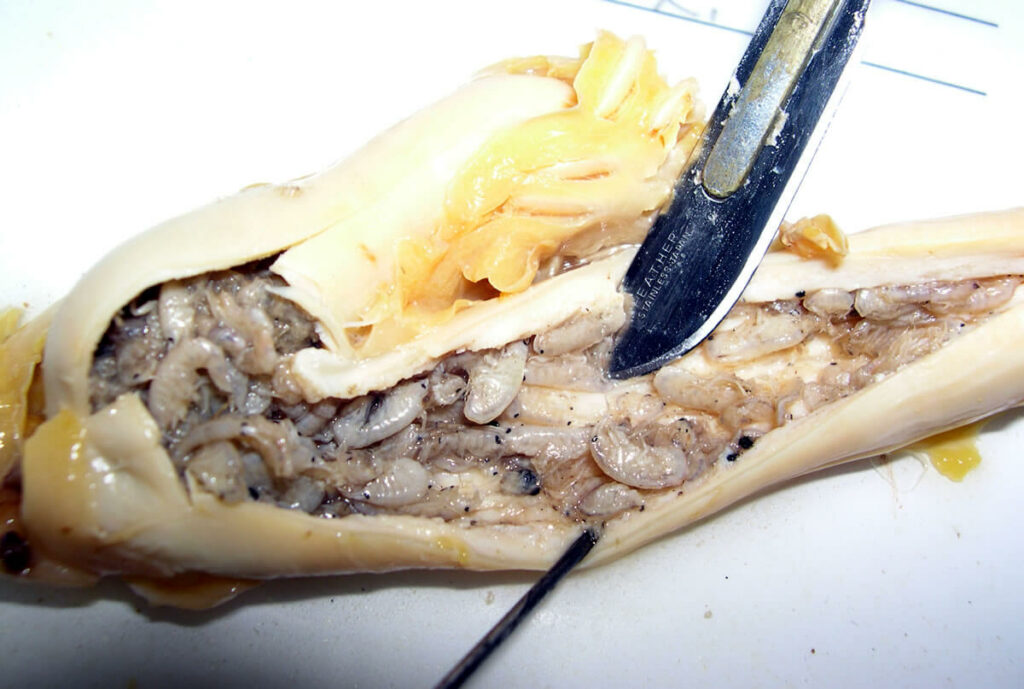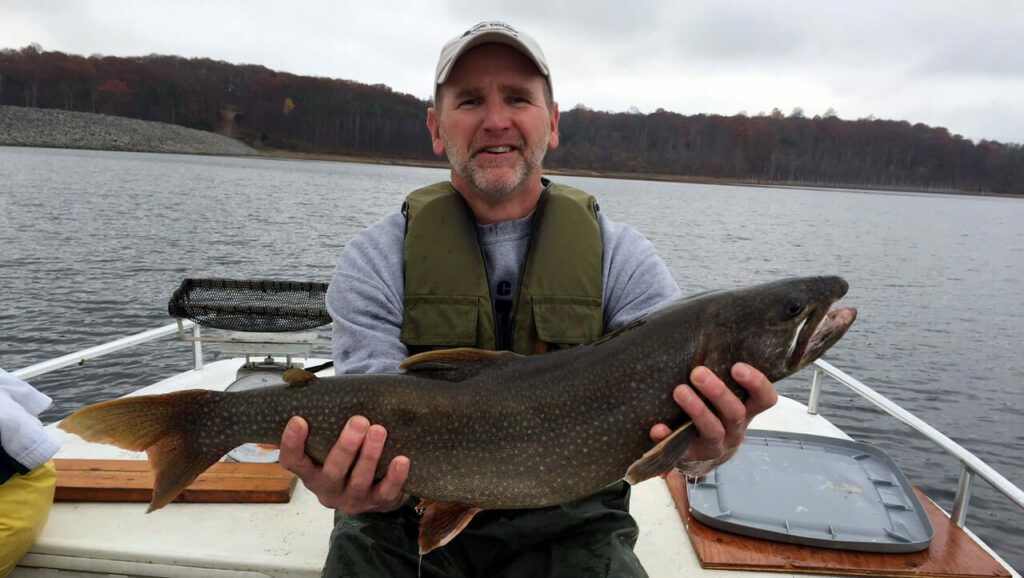
Print version (pdf, 50kb)
Lake Trout (Salvelinus namaycush) fisheries exist in two New Jersey waterbodies: Round Valley Reservoir and Merrill Creek Reservoir. Although stocked for years, the Lake Trout populations in these two reservoirs are now entirely supported by natural reproduction and are no longer stocked by Fish and Wildlife.
Surplus Lake Trout were periodically stocked into Monksville Reservoir from 2004 – 2012, however a significant fishery never developed. As a result, Lake Trout are no longer stocked by the state anywhere in New Jersey.
Round Valley Reservoir
The Lake Trout population in Round Valley Reservoir is closely monitored by Bureau of Freshwater Fisheries to evaluate the status of this trophy trout fishery. Lake Trout reared at the Hackettstown State Fish Hatchery were stocked in this deep reservoir (maximum depth 160 feet) from 1977 until 1995. In 1985, evidence of natural reproduction within the reservoir was documented. By 1995 it was determined that the population was capable of maintaining itself by natural reproduction, thus stocking was discontinued.
Gill net surveys were conducted annually up to 2018 but are now conducted every 2 years in the fall when mature Lake Trout seek out suitable spawning habitat along the boulders lining the reservoir’s dams. Unfortunately, due to the Covid-19 pandemic, Lake Trout sampling did not take place in 2020, but sampling is expected to be performed in 2022. Eight experimental gill nets, each net with varying mesh size openings, are used to capture a range of Lake Trout from juveniles to sub-adults. Eight additional large-mesh gill nets (6″ stretch mesh) are set near the reservoir’s north and south dams to capture mature Lake Trout as they begin congregating to spawn over the rocky substrate. Length and weight data are collected to assess physical condition of the fish using relative weight analysis. In addition, sex, fin clips, and sexual development information are also recorded.
The number of Lake Trout over 25 inches encountered during our monitoring program has steadily declined since 1996. During the mid-1990s more than 40 individual fish over 25 inches were documented. That number has decreased to single digits in recent years (see figure below). Unfortunately, the trend of decreasing numbers of large Lake Trout is resulting in a less-desirable trophy Lake Trout fishery. 2014 was the first year no Lake Trout over 30 inches or more than ten pounds were caught, however two large Lake Trout were caught in 2015. The largest individual was a female measuring 39.3 inches and weighing 22.6 lbs. (at right). Despite few individuals reaching trophy proportions, the Lake Trout population is doing well, as the total number documented while monitoring has steadily increased since 2001.
In 2008 and then again in 2012, the regulations were modified to increase harvest, aiming to reduce competition and facilitate better condition and faster growth. This management strategy seems to have worked, as the number of Lake Trout from 15 to 20 inches has declined, while those from 20 to 25 inches have increased (see figure below). NJFW plans to continue to encourage the harvest of Lake Trout from 15 to 24 inches with the intention of achieving a more desirable trophy fishery.

Round Valley Reservoir Salmonid Diet Study
In order to better understand the composition of trout diets in Round Valley Reservoir, volunteers from Round Valley Trout Association collected trout stomachs from fish that were caught during their monthly tournaments. The primary purpose was to determine if the contribution of baitfish (primarily Alewives and Golden Shiners) in the diet of Rainbow, Brown, and Lake Trout in Round Valley Reservoir. Stomachs were preserved in ethanol and later analyzed by NJFW staff.
Ninety-eight stomachs were collected on 12 different days from April 16 to September 12, 2015. Of the 90 Lake Trout, only 4 had fish in their stomachs (2 unknown Clupeids and 2 unknown Shiners, however 1 had a hook in its back). Results were similar to previous efforts during 2006, 2007, 2009, and 2010 with 8 of 158 (5%) of Lake Trout having fish in their stomachs, with scuds (Gammarus sp.). One of two Brown Trout had 12 unknown shiners in its stomach. The data will be used, in conjunction with other measures, to determine the status of the baitfish population at the reservoir.
Merrill Creek Reservoir
Merrill Creek Reservoir is a 650-acre privately-owned reservoir located in Harmony Twp., Warren County that is open to public fishing. Following construction and filling in 1988, a variety of fish species have been stocked in this deep-water reservoir (200 ft deep) by NJFW to establish and maintain desirable sport fisheries for Smallmouth Bass as well as Rainbow, Brown, and Lake Trout.
The reservoir’s fishery is managed by the Merrill Creek Owners Group in cooperation with Fish and Wildlife. This team meets annually to review and discuss fisheries data collected and to make management decisions. Lake Trout surveys are conducted every other year in the fall using gill nets. When the gill net survey data indicated that Lake Trout were naturally reproducing in the reservoir, stocking of this species was discontinued in 2013.
2015 Lake Trout Population in Round Valley Reservoir (Presentation to Round Valley Trout Association, pdf, 3.5mb)
 Official Site of The State of New Jersey
Official Site of The State of New Jersey



